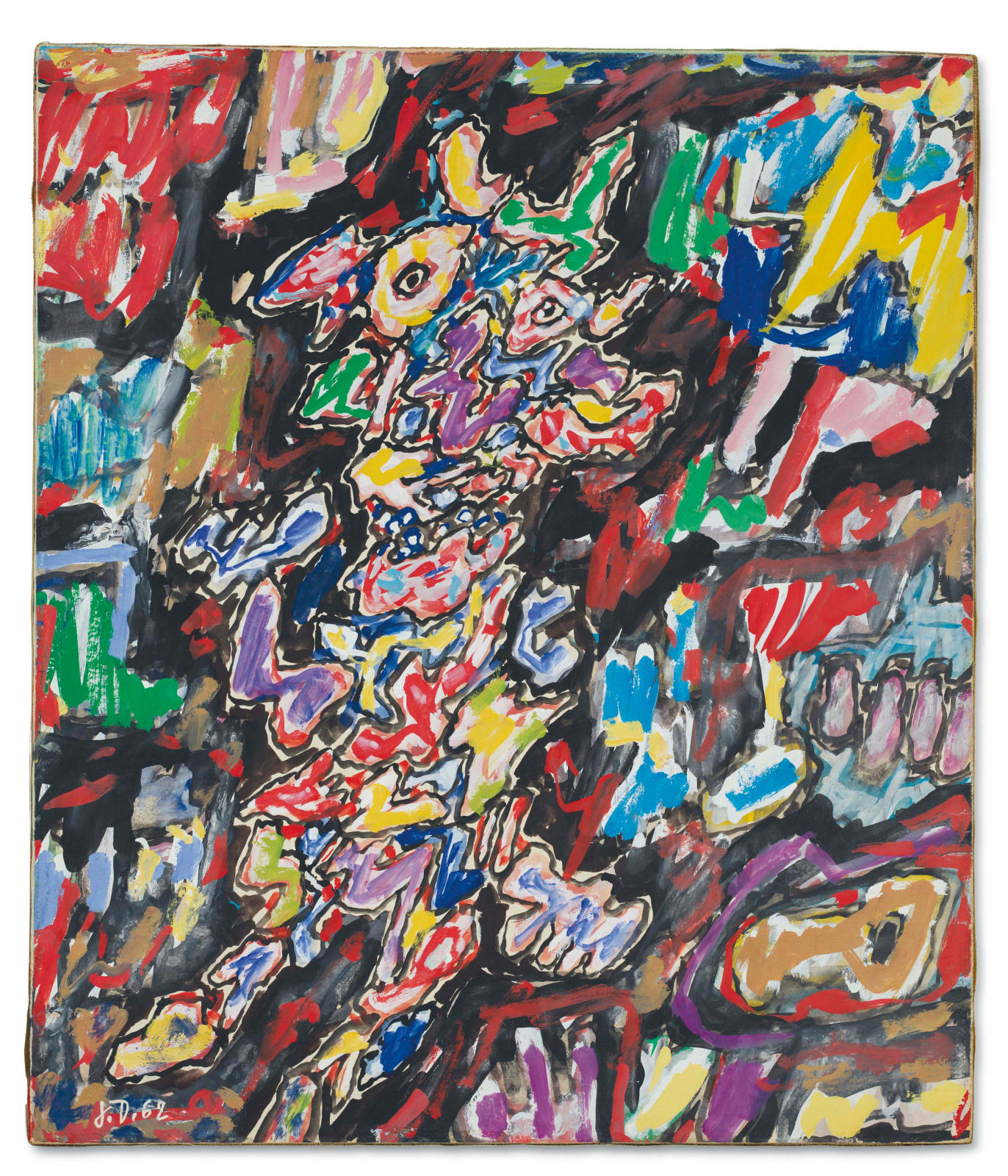Jean Dubuffet
Personnage et paysage, 1962
Gouache on paper laid down on canvas
18 7/8 x 16 1/8 in, 48 x 41 cm
Signed and dated 'JD 62' lower left
‘Personnage et paysage’ belongs to Dubuffet’s distinctive 1962 series ‘Personnage des Légendes’. This series was a part of Dubuffet’s highly important ‘Paris Circus’ cycle, which includes what are considered some...
‘Personnage et paysage’ belongs to Dubuffet’s distinctive 1962 series ‘Personnage des Légendes’. This series was a part of Dubuffet’s highly important ‘Paris Circus’ cycle, which includes what are considered some of his greatest and most influential works. With their jubilant colour palette and unique pictorial language they fully encapsulate the artist’s artistic vision. Having just returned to Paris after seven years in the countryside, this series is a homage to Paris and its people. Dubuffet described how “The presence in them of the painter now is constant, even exaggerated. They are full of personages, and this time their role is played with spirit”.
In ‘Personnage et paysage’, Dubuffet distils the scene, focusing on a singular figure in the midst of the bustling city. It is a painting brimming with life that shows Dubuffet’s inquisitive eye and interest in the physical and mental environment of the individual. ‘Personnage et paysage’ is quintessential of the art brut Dubuffet championed, displaying his pushing of the creative possibilities and conventional boundaries of the time.
In 1962 the year he created ‘Personnage et paysage’, the Museum of Modern Art, the Art Institute of Chicago and the Los Angeles County Museum of Art jointly held a major retrospective of the artist’s work. It was also in July of that year that he began his famous ‘Hourloupe’ series, which had evolved from a chance doodle whilst he was on the telephone. The figure in ‘Personnage et paysage’ is a precursor to the ‘Honoloupe’, with its interlocking jigsaw of forms. However, it steps away from the limited three colour palette of white, red, and blue, instead embracing a vivacious assembly of tones. Dubuffet believed that this style (a tangle of lines filled with unmixed colour) evoked the way images appear in the mind.
Dubuffet initially studied painting at the Académie Julian in Paris. However, disillusioned by its conservatism, he left after only six months. Having rejected conventional practice, Dubuffet was instead drawn to art brut - his term for the art of the insane, children and "primitives". Assimilating these forms into his own work, he developed a highly graphic style with which he dominated the post-war art scene in France, becoming one of the most important and revolutionary artists of his time. In the present work, the simplified figure emerges amongst the boldly coloured and childlike scribbles display Dubuffet’s belief that art brut offered “truer” modes of expression than classical art.
‘Personnage et paysage’ was first exhibited at Galerie Daniel Cordier - Dubuffet’s Parisian dealer - where a large exhibition of Dubuffet’s work was held in 1962. It was also included the exhibition ‘Visione colore: mostra internazionale d'arte contemporanea’ at Palazzo Grassi in Venice the following year.
In ‘Personnage et paysage’, Dubuffet distils the scene, focusing on a singular figure in the midst of the bustling city. It is a painting brimming with life that shows Dubuffet’s inquisitive eye and interest in the physical and mental environment of the individual. ‘Personnage et paysage’ is quintessential of the art brut Dubuffet championed, displaying his pushing of the creative possibilities and conventional boundaries of the time.
In 1962 the year he created ‘Personnage et paysage’, the Museum of Modern Art, the Art Institute of Chicago and the Los Angeles County Museum of Art jointly held a major retrospective of the artist’s work. It was also in July of that year that he began his famous ‘Hourloupe’ series, which had evolved from a chance doodle whilst he was on the telephone. The figure in ‘Personnage et paysage’ is a precursor to the ‘Honoloupe’, with its interlocking jigsaw of forms. However, it steps away from the limited three colour palette of white, red, and blue, instead embracing a vivacious assembly of tones. Dubuffet believed that this style (a tangle of lines filled with unmixed colour) evoked the way images appear in the mind.
Dubuffet initially studied painting at the Académie Julian in Paris. However, disillusioned by its conservatism, he left after only six months. Having rejected conventional practice, Dubuffet was instead drawn to art brut - his term for the art of the insane, children and "primitives". Assimilating these forms into his own work, he developed a highly graphic style with which he dominated the post-war art scene in France, becoming one of the most important and revolutionary artists of his time. In the present work, the simplified figure emerges amongst the boldly coloured and childlike scribbles display Dubuffet’s belief that art brut offered “truer” modes of expression than classical art.
‘Personnage et paysage’ was first exhibited at Galerie Daniel Cordier - Dubuffet’s Parisian dealer - where a large exhibition of Dubuffet’s work was held in 1962. It was also included the exhibition ‘Visione colore: mostra internazionale d'arte contemporanea’ at Palazzo Grassi in Venice the following year.
Provenance
Galerie Daniel Cordier, Paris (acquired in 1962)Galleria del Naviglio, Milan (acquired in 1963-4)
J Krugier Gallery, New York
Dennis Hotz Fine Art, Johannesburg
Private Collection (acquired from the above)
Exhibitions
Rome, Marlborough Galleria d'Arte, Dubuffet, March-April 1963, no.67Venice, Palazzo Grassi, Visione colore: mostra internazionale d'arte contemporanea, July-October 1963, illus.
Milan, Galleria del Naviglio, Jean Dubuffet, March-April 1964
Literature
M. Loreau, Jean Dubuffet: Catalogue des travaux de Jean Dubuffet, fascicule XIX, Paris Circus, Paris, 1989, p.163, no.351, illus.2
of
2



